EXERCISES TO RELIEVE CONSTIPATION AND GAS - 8 EXAMPLES
- Medically reviewed by: Horia Marculescu, MD
- Photo credits: Licenses / Author
- Last updated: 29.05.2024
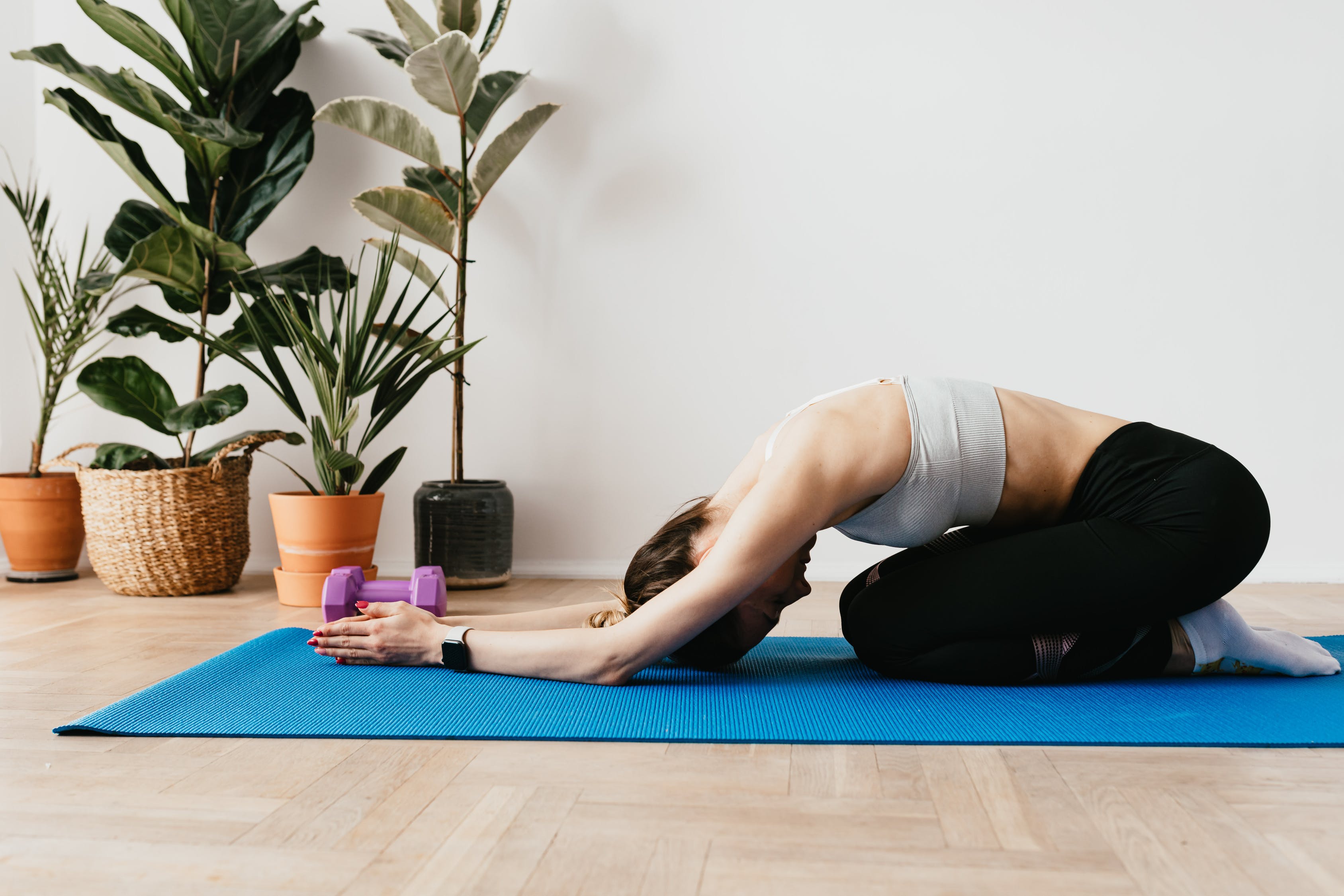
Constipation and gas stem from common causes such as poor dietary combinations, dehydration, or insufficient physical activity.
To alleviate these symptoms and enhance digestion, consider incorporating eight exercises to relieve constipation and gas into your routine: Balasana, crunches, deep squat, supine twist, forward lunges, wind-relieving pose, legs up-the-wall pose, and half knees to chest pose.
Specific exercises target the abdominal region predominantly, like crunches, while others, such as Balasana and the wind-relieving pose, originate from yoga. Additionally, exercises like deep squats excel in strengthening the pelvic floor.
Follow the guide and use these exercises for both constipation and gas relief. Put your body to work out and get in shape in the comfort of your home.
- TABLE OF CONTENTS
- 1. BALASANA
- 2. CRUNCHES
- 3. DEEP SQUAT
- 4. SUPINE TWIST
- 5. FORWARD LUNGES
- 6. WIND-RELIEVING POSE
- 7. LEGS UP-THE-WALL POSE
- 8. HALF KNEES TO CHEST POSE
- UNDERSTANDING GAS FORMATION IN THE INTESTINES
- WHAT KEEPS THE GAS INSIDE THE INTESTINES?
- AVOID THE FOLLOWING FOODS TO PREVENT GAS FORMATION
- SUMMARY
1. BALASANA
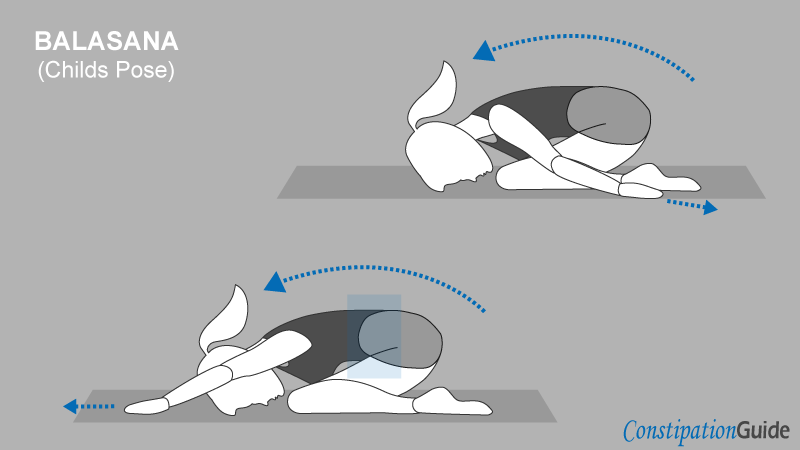
Balasana (Child’s Pose or Child’s Resting Pose) is a modern yoga pose used everywhere. It is simple and requires little effort to practice.
This yoga pose is one of the best exercises to relieve constipation and gas because it contracts the abdomen and increases the anorectal angle. These things create sufficient pressure to evacuate the stool and the gas.
Try combining this yoga posture with a few exercises like crunches, swimming, and jogging to have better results in the long term.
How to effectively utilize Balasana for relief from gas and constipation:
- Lay a yoga mat on the floor.
- Position your body facing down on the mat, resembling a squat.
- Maintain contact between your forehead and shoulders with the mat.
- Place your palms flat on the mat, close to your hips.
- Hold this posture for 3-5 breaths.
- Gradually lift your body and repeat the sequence.
Repeat this routine 10-15 times, interspersed with short breaks. Alternatively, you can extend your arms and palms forward.
Start with a warm-up and perform stretching exercises beforehand to prevent muscle soreness associated with constipation.
Evidence from a review on physical exercise and yoga, issued by The U.S. National Center for Biotechnology Information, suggests that yoga delivers results equal to or better than traditional exercise.
2. CRUNCHES
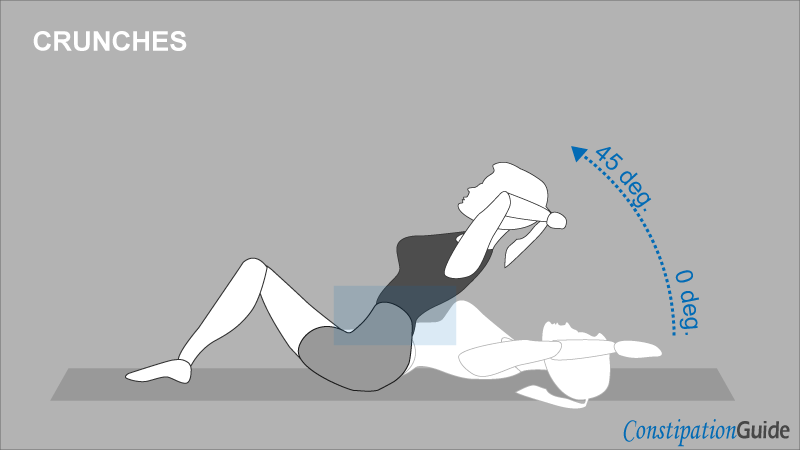
Crunches are probably the most effective exercises to relieve constipation and gas because they put the abdominal muscles to work. Crunches are similar to sit-ups. They also work the pelvic floor muscles.
Also, crunches create lots of pressure for the gas to push the stool towards the rectum. This type of exercise is excellent for abdominal workouts and warm-ups.
Sometimes, crunches and sit-ups can cause constipation when you combine a workout with fatigue, stress, or other symptoms.
How to perform crunches to relieve constipation and gas:
- Start by positioning your back and bottom on the fitness mat.
- Keep your body straight, parallel to the floor.
- Lift your knees halfway toward the ceiling.
- Position your arms behind your head.
- Inhale deeply.
- Next, lift your body and head towards your knees.
- Return to the starting position and exhale.
Repeat this exercise 10 times, completing 5-10 sets. Aim to bring your chin closer to your knees with each repetition. Begin slowly and gently.
Focus on inhaling slowly to fill your lungs. Exhale the air from your lungs when your upper body is perpendicular to the floor. This technique optimizes your breathing, aiding in the release of trapped gas and relieving constipation.
3. DEEP SQUAT

The deep squat posture is one of the best exercises to relieve constipation and gas. The reason is that it creates a clear path for the stool and gas to evacuate. This action is possible by increasing the anorectal angle and relaxing the puborectalis muscles.
The deep squat is an excellent exercise to stimulate bowel movement in the long term. Also, it is a practical workout for your pelvic floor muscles.
Utilizing Deep Squats for Gas Relief:
- Begin by standing with your feet positioned straight.
- Slowly lower your bottom towards the floor.
- Pause when your knees surpass the height of your hips.
- Maintain this stance for 5-10 breaths.
- Return to the starting position.
Repeat this exercise 5-15 times gradually, allowing for breaks as necessary. Ensure that your knees remain elevated above your hips throughout the movement. You can rest your arms and elbows on your knees to feel comfortable.
According to a health guide about maintaining a healthy digestive system published by The Australian Digestive Health Foundation, Regular cardio exercise stimulates the intestinal muscles to move the fecal matter towards evacuation (improve bowel movement). Also, cardio exercise helps to strengthen the abdominal muscles.
4. SUPINE TWIST
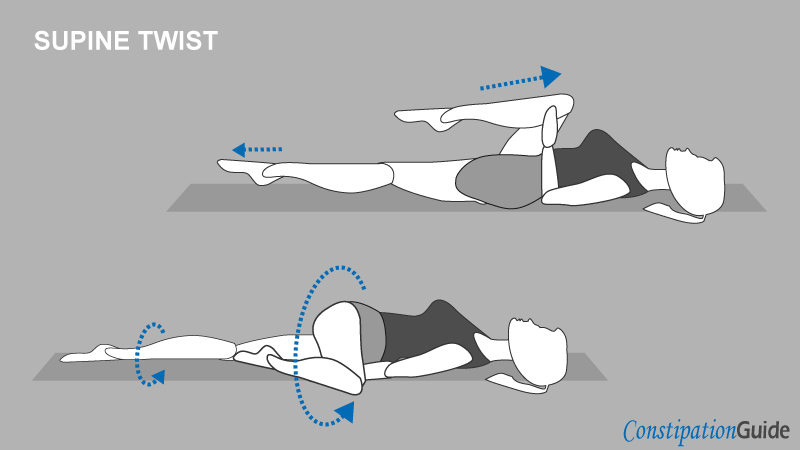
The Supine Twist is one of the few yoga poses that help digestion by moving the stool inside and increasing the blood flow to your gut. It is an excellent way for stress relief. It helps evacuate the stool and the gas inside the large intestine.
How to use the Supine Twist for gas relief?
- Place the back of your body flat on a yoga mat.
- Keep your body straight.
- Bring the right knee to your chest.
- Keep the other leg straight.
- Now, bend your right leg over the left one.
- Place your right knee on the floor.
- Hold this posture for 3-5 breaths.
- Return and switch sides.
Repeat this gentle yoga twist 5-10 times slowly. Try to keep your body straight as much as possible.
According to The American College of Gastroenterology - “Experts say exercise benefits patients (with IBS, IBD)”: Yoga is a way to maintain good health (The Center for Functional HI and Motility Disorders). Also, Low-impact workouts that do not involve jarring movements are beneficial to IBD.
5. FORWARD LUNGES
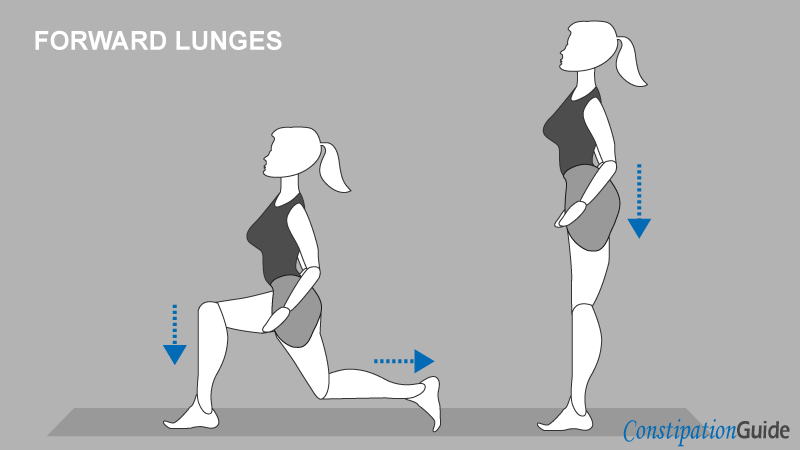
Forward Lunges are excellent exercises to relieve gas and constipation because they increase the anorectal angle and create pressure inside the intestines.
Like the deep squat exercise, this workout offers a practical solution for quickly relieving constipation.
If you keep your body near the floor for more than four breaths, you will work the pelvic floor muscles. Also, it puts to work the hips, knees, and abdomen. This thing is beneficial to prevent muscle soreness.
Here's how to perform Forward Lunges to alleviate constipation and gas:
- Stand tall with your feet hip-width apart.
- Take a controlled step forward with your right leg.
- Keep your left foot firmly planted on the floor.
- Lower your body by bending both knees and bringing your right thigh parallel to the floor.
- As you lower, ensure your torso remains upright and engage your core muscles.
- Lower your left knee towards the ground, maintaining a smooth, controlled movement.
- Once your left knee lightly touches the ground, press through your right heel to return to the starting position.
- Repeat on the other side by stepping forward with your left leg.
Focus on maintaining proper form and controlled movements throughout the exercise. This dynamic movement can help stimulate digestion and alleviate discomfort associated with constipation and gas.
According to an article on functional gastrointestinal and motility disorders published by the International Foundation for Gastrointestinal Disorders, pelvic floor physical therapy has been shown to aid in reducing fecal incontinence episodes, particularly in children with pelvic floor dyssynergia.
6. WIND-RELIEVING POSE

The Wind-Relieving Pose stands out as a highly effective yoga posture for long-term use due to several reasons:
- It enhances the anorectal angle.
- It efficiently alleviates gas discomfort.
- It engages and strengthens the abdominal muscles.
Incorporating this pose into your fitness routine on a yoga mat at home offers an excellent opportunity to sculpt your abdomen.
The Wind-Relieving Pose is an optimal choice for patients seeking a straightforward exercise.
Here's how to perform the Wind-Relieving Pose for relief from constipation and gas:
- Lay a yoga mat on the floor.
- Lie flat on your back, ensuring your body is aligned parallel to the floor.
- Keep your legs extended straight.
- Draw both knees toward your chest.
- Gently clasp your knees with your arms, securing them in place.
- Hold this pose for 3-5 breaths and allow deep, steady inhalations and exhalations.
- Release the pose gently and repeat as desired.
Gradually incorporate this exercise into your routine, aiming for 5-10 repetitions (each session). Approach each repetition slowly and gently, respecting your body's limits without overexertion.
7. LEGS UP-THE-WALL POSE
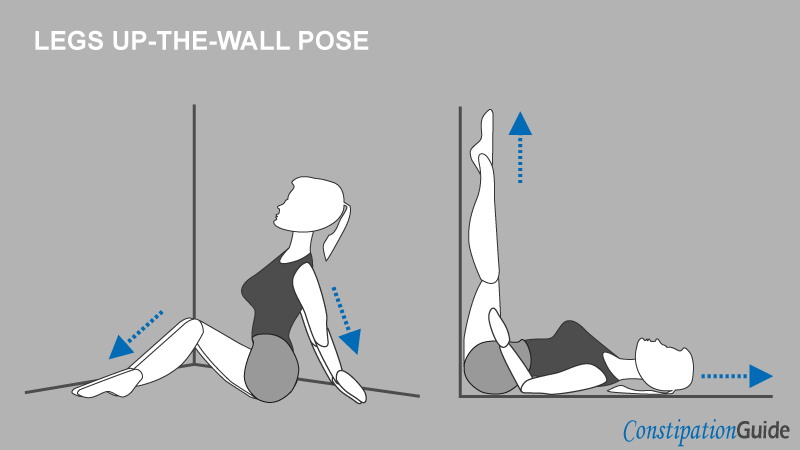
Using this pose is one of the easiest ways to get rid of constipation and gas. The exercise involves you keeping your feet vertical to the floor. And hold them like that for 5-15 breaths.
Everyone can use this position to stimulate bowel movement with ease. The only thing you need is a fitness mat and a wall.
Steps for Practicing the Legs-up-the-Wall Pose:
- Place a fitness mat near a wall.
- Position your body parallel to the wall.
- Lay on your back and bring your feet up.
- Rotate your body with your feet on the wall.
- Adjust your position with your hands.
- Keep this position for 5-15 breaths.
- Now, return to the initial posture.
Repeat this exercise 5-10 times slowly. The more you stay with your feet up the wall, the better the gas will move for evacuation.
8. HALF KNEES TO CHEST POSE
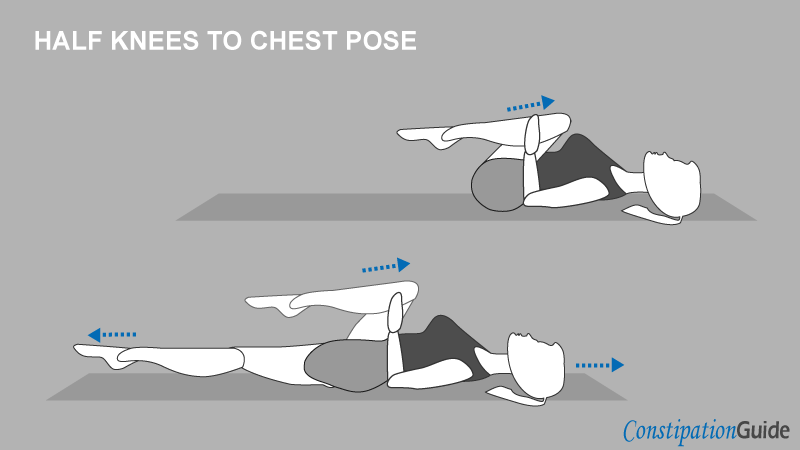
This pose is similar to crunches because the movement involves working out your abdomen by sitting on your back.
The difference between crunches and working out with this pose is that you sit on your back. And you bring your knee closer to the chest.
Here are the steps to use the half knees to chest pose:
- Lie on your back on a fitness mat.
- Maintain a straight alignment of your body throughout the exercise.
- Ensure your feet remain parallel to the floor.
- Begin by bringing one knee toward your chest.
- Use your arms to support and hold the knee in place.
- Hold this position for 2-3 deep breaths, focusing on relaxation.
- Release the knee and switch to the other leg.
Repeat this exercise 5 times for 5-10 series. Start slowly and gently, and always keep your body straight. Bring one knee at a time and breathe slowly and deeply.
UNDERSTANDING GAS FORMATION IN THE INTESTINES
Before employing these exercises to alleviate constipation and gas, it's crucial to grasp what causes gas.
Gas results from two main events:
- Fermentation of sugary foods.
- Rapid consumption of food.
Sugary foods, fruits, and carbonated drinks contribute to gas formation within the intestines.
Sugary foods predominantly instigate intestinal gas production. Foods containing sugar, glucose, or fructose tend to ferment rapidly due to heat and humidity.
For swift relief from constipation, combining fruit consumption with exercise can expedite the defecation process.
Intestinal fermentation necessitates:
The higher the sugar content in food, the quicker the fermentation process. Fruits and cereals ferment at elevated temperatures to produce alcohol.
Various foods contribute to gas production, including sugar, glucose, fructose, flour, honey, milk, yogurt, bread, rice, potatoes, starchy items, bakery products, cabbage, beans, and carrots.
Carbonated sugary drinks, fruit juice, beer, carbonated water, champagne, and soda create gas.
Grapes, prunes, apples, oranges, bananas, peaches, and watermelons also create gas.
Rapid eating is a significant factor in the development of constipation and gas. Rushing through meals often disrupts proper digestion, leading to adverse effects.
This behavior, known as aerophagia or air swallowing, introduces excess air into the intestines, hindering effective food digestion.
According to a study titled "Aerophagia and Intestinal Gas." published by The U.S. National Library of Medicine, aerophagia is a relatively uncommon condition characterized by repetitive air swallowing and belching. Aerophagia affects both children and adults and potentially causes abdominal distention.
Furthermore, a technical review on constipation published by The National Center for Biotechnology Information indicates that gas formation occurs when unabsorbed carbohydrates metabolize with bacteria.
WHAT KEEPS THE GAS INSIDE THE INTESTINES?
Constipation usually means difficulty moving stool from the large intestine to the rectum. After the small intestine assimilates food, the formed stool moves toward the large intestine.
Air pockets or bubbles become trapped between old and new fecal matter. These things happen when then fecal matter sticks to the intestinal walls.
Large amounts of hard, dry stool typically block the air inside the large intestine, causing bloating, an expanding belly, and the urge to pass gas.
Whenever you do some exercises to relieve constipation and gas, the following things happen:
- Abdominal muscles contract and move.
- Muscle contraction and movement create pressure.
- The pressure pushes the gas.
- Gas presses the stool forward.
- The formed stool moves.
Pressure and muscle movement are essential to push the stool using gas. This domino effect relies on exercise and muscle movement.
If stool sticks to the intestinal walls, gas slides between the walls and the fecal matter. After passing through the rectum, the gas evacuates, a process called flatulence.
A medical study by the U.S. National Institutes of Health found that some patients with functional gastrointestinal disorders and moderate bloating might be hypersensitive to products that ferment in the colon.
The same study indicates that abdominal bloating results from abnormal reflexes, impaired gas handling, and visceral hypersensitivity.
AVOID THE FOLLOWING FOODS TO PREVENT GAS FORMATION
Avoid eating large quantities of bananas and any juice containing bananas. Bananas turn into a sweet starch that ferments quickly.
Grapes, which are high in sugar, also ferment rapidly. If bananas and grapes remain in the intestines too long, they ferment and create alcohol.
Fermentation causes pressure and gas, prompting the intestines to evacuate the gas immediately. This thing leads to unpleasant situations like:
- Flatulence;
- Bloating;
You may also experience frequent belly expansion and sometimes abdominal discomfort.
Avoid eating meat with bread or any carbohydrate product. Combining these foods disrupts digestion and creates hard and dehydrated stools.
According to an official health guide on Nutrition and Physical Activity by the Australian Department of Health, eating fruits, vegetables, and legumes is essential to obtain a wide range of vitamins and minerals.
According to a review on constipation published by The American Gastroenterological Association Institute, Mild physical activity relieves bloating and reduces intestinal gas. Moderate and intensive physical activity improves health and IBS symptoms (20-60 min, 3-5 days/week).
SUMMARY
Food fermentation and Aerophagia (air swallowing) are the causes of intestinal gas. Gas stays blocked inside the large intestine between new and old stool.
The following exercises to relieve constipation and gas bring many benefits to digestion and overall health: balasana, crunches, deep squat, cobra pose, supine twist, forward lunges, wind-relieving pose, legs up-the-wall pose, and half knees to chest pose.
All of these exercises are simple and require a fitness mat. Practice them using this guide in the comfort of your home.
Last medically reviewed on 29.05.2024
